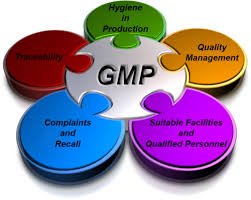Current Good Manufacturing Practices – CGMP in Pharmaceutical Industries

📌 Current Good Manufacturing Practices (cGMP) in Pharmaceutical Industries
Definition:
cGMP (Current Good Manufacturing Practices) are the regulations enforced by regulatory authorities (like US FDA, EMA, WHO, MHRA, CDSCO, etc.) to ensure that pharmaceutical products are consistently produced and controlled according to quality standards.
The term “current” implies that companies must use the latest, up-to-date technologies, systems, and methods for manufacturing and quality assurance.
🔹 Objectives of cGMP
-
To ensure safety, identity, strength, quality, and purity of drug products.
-
To minimize risks such as contamination, mix-ups, deviations, and errors.
-
To maintain patient safety and therapeutic effectiveness.
-
To comply with regulatory requirements and avoid penalties.
🔹 Key Elements of cGMP
-
Quality Management System (QMS)
-
Strong QA oversight, documentation, and continuous monitoring.
-
Adherence to ICH Q10 Pharmaceutical Quality System.
-
-
Personnel & Training
-
Adequately qualified and trained staff.
-
Ongoing GMP training and competency checks.
-
-
Premises & Equipment
-
Facility design to prevent cross-contamination.
-
Qualified and calibrated equipment.
-
Proper maintenance and cleaning.
-
-
Raw Materials Control
-
Supplier qualification and vendor audits.
-
Testing and approval of incoming materials.
-
-
Production Controls
-
Following approved batch manufacturing records (BMR).
-
In-process checks.
-
Process validation and continuous monitoring.
-
-
Quality Control (QC) & Laboratory Controls
-
Analytical method validation.
-
Proper sample handling, testing, and result recording.
-
Out of Specification (OOS) investigations.
-
-
Documentation & Record Keeping
-
Compliance with ALCOA+ principles.
-
Master Batch Records, SOPs, logbooks, deviation/change control records.
-
-
Validation & Qualification
-
Equipment qualification (IQ, OQ, PQ).
-
Process validation, cleaning validation, computerized system validation.
-
-
Complaint Handling & Recall
-
Market complaint system and investigation.
-
Efficient recall procedures to protect patient safety.
-
-
Audits & Inspections
-
Internal audits/self-inspections.
-
Regulatory inspections (FDA, EMA, WHO).
🔹 Importance of cGMP
-
Ensures consistent product quality.
-
Builds patient and healthcare provider confidence.
-
Prevents regulatory non-compliance (FDA 483s, warning letters).
-
Reduces risk of adulteration, contamination, or misbranding.
-
Promotes continuous improvement and innovation.
🔹 cGMP Guidelines & References
-
US FDA 21 CFR Parts 210 & 211 – for finished pharmaceuticals.
-
EU GMP Guidelines (EudraLex, Volume 4).
-
WHO GMP Guidelines.
-
ICH Q7, Q8, Q9, Q10.
-
Schedule M (India) – GMP requirements.
🎓 Discover one of the best Complete Pharmaceutical Quality Assurance Course available —click below to explore the course that’s shaping future in QA Course skills.

